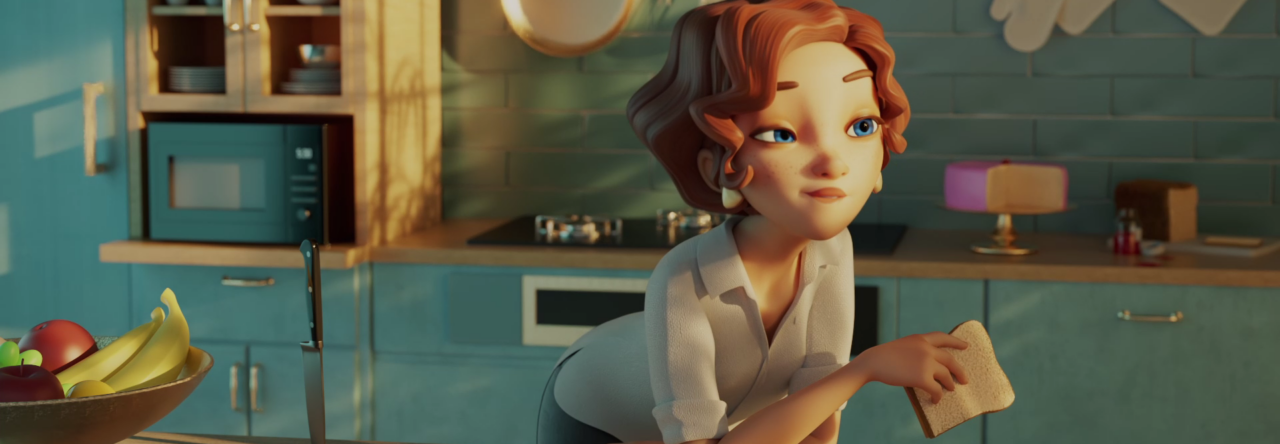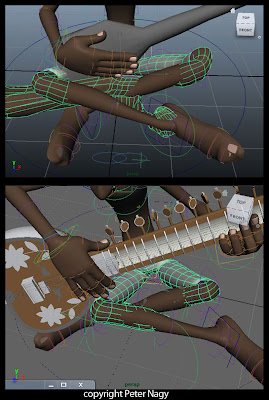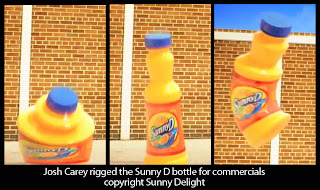AnimSchool presents: an animation by Mitchell Coote reviewed by, Pixar Animator, Mark Harris.
When we first announced the public release of the Malcolm rig, we were very excited to see what the animation community would produce. We were gratified to see this past month’s 11 Second Club winner again using our Malcolm rig. Congratulations to long-time contestant Peter Nagy!
Peter, thanks for being a part of this interview. Can you start off by telling us a little bit about yourself, your background and how you became an animator?
 I started this profession at Kecskemetfilm, in Hungary in 2000 as an inbetweener. This studio took part in the animation of Secret of Kells and the fresh Chico & Rita. I moved to Budapest after that, where I worked in Mr. Bean: The Animated Series. I have been using traditional animation technique since 2005, which I like a lot. Since there was less and less 2D work, I took up digital animation, from about 2008 onward. At first I used CG 2D technique (Anime Studio), then I worked with Maya, which I have been using ever since. The latest known production I worked on was Assassin’s Creed Revelations at Digic Pictures. Presently, I’m lead animator at an advertising studio, Gyár Post Production.
I started this profession at Kecskemetfilm, in Hungary in 2000 as an inbetweener. This studio took part in the animation of Secret of Kells and the fresh Chico & Rita. I moved to Budapest after that, where I worked in Mr. Bean: The Animated Series. I have been using traditional animation technique since 2005, which I like a lot. Since there was less and less 2D work, I took up digital animation, from about 2008 onward. At first I used CG 2D technique (Anime Studio), then I worked with Maya, which I have been using ever since. The latest known production I worked on was Assassin’s Creed Revelations at Digic Pictures. Presently, I’m lead animator at an advertising studio, Gyár Post Production.
Why did you decide to use AnimSchool’s Malcolm rig for your animation?
More and more new characters have been appearing on 11 Second Club lately, and people always welcome animations related with fresh rigs. I heard about the appearance of Malcolm, but at that time only his XSI version was available. My hard-working Hungarian colleagues at Puppetworks made the Maya version of the character and sent it to me for testing. However, at that time I was so busy I couldn’t have a look at it. Only at the beginning of this year could I manage to open the file to test it. In your first promo video the animation of the character is amazing and I was interested in the rig. Only then I saw that your Maya version is available too, so I used that one.
Was this the first time you used ever Malcolm, or did you have any previous tests to warm up before?
The very first time. Previously, I didn’t even have time for a wink-test. I’m very pleased that my first animation with Malcolm became so successful.
What was it like working with the Malcolm rig? It looks like you were able to get some strong lines of action and appealing poses.
Malcolm is the best rig I have ever worked with! (And I’m not only saying this because I won with Malcolm) Until now, I have always thought that there are no bad rigs, just weak animators, but I have found out, it is crucially important how much latitude a rig can give to the animator. At first I got frightened by seeing the amount of controllers, but with a little practice, it can easily be seen which controller should be used to which action. It was a great help that I could change body position by moving the hip or the abdomen, and the shoulders kept their position at the same time. I loved that I could handle the arms in arch and that I could stretch the character. These are very important factors on a rig for a nice cartoony animation.
I’m impressed with your Malcolm modifications. Malcolm has pants, shirt, and shoes, but you’ve managed to make a totally different wardrobe. My favorite part is the new foot with little toenail pieces to suggest toes. Very creative and all your changes add up to a convincing new look. How involved was that process and what methods did you use?
At first I thought that for all those naked body parts a supplementary foot model would be needed for the character (I used this supplement for a previous work of mine, in Pinocchio). But in the end, I managed to transform the sneaker to a foot. Separate toes were not made, but with the toenails, it had the foot-effect. It was a much greater task to put together the creasy trousers and the leg-elements. This is the reason why the leg moves so limited in the scene. I also had to put together two objects at the neck, this part required vertex animation for the final appearance. From the camera’s viewpoint, the head luckily covers out this part and the render blurred together these small irregularities on the skin.
Mother Earth – Winner of 11 Second Club January Competition from Peter Nagy on Vimeo.
Interview by: Andrew Tran and Dave Gallagher
Watch for Part 2 of this interview, coming soon.
AnimSchool Instructor and Blue Sky Animator, Matt Doble, discusses how to anticipate the weight of an object and the importance of showing counterbalance.
Tough question 🙂
AnimSchool friend Peter Nagy used our Malcolm character in his winning 11 Second Club entry this past month! His entry came in 1st out of 135 entries.
Take a look at the inventive ways he has modified our Malcolm rig for these creative new looks!
A big congratulations to 2D and 3D animator, Peter Nagy for making what is clearly the best entry this month.
Did you know most anyone can download and use AnimSchool’s Malcolm character for free? Yes, indeed.
Mother Earth – Winner of 11 Second Club January Competition from Peter Nagy on Vimeo.
Dave Gallagher, founder of AnimSchool, reviews Gary Hsu’s 3D model from his Intermediate Modeling class.
AnimSchool students can learn 3D modeling. This review was done during AnimSchool’s General Reviews. General Reviews are held once a week for those students who can’t attend their class review and those wanting an extra critique.
Character Design by Brent Gordon.
AnimSchool presents: an animation by Edwin Schaap reviewed by Mark Harris, an animator from Pixar!
In part 1 of Showing Weight, AnimSchool Instructor and Blue Sky Animator, Matt Doble, draws examples showing the heavier something is, the more effect it will have on the body.
In upcoming part 2, Matt discusses anticipating the weight of an object.
Thanks a lot for having me!
 Well, Blue Sky was my first real job in the animation industry, so I think I probably developed most of my technical modeling skill there. I learned a lot about how a production pipeline works, and saw films grow from ideas, to storyboards, to artwork, to animation and so on all the way to the big screen. I genuinely love the team there. On a side note, I started there as a production assistant, and the thing that immediately jumps to mind that I learned (the hard way) is to never, never use the paging system to make a page that the whole company can hear without carefully considering exactly what you’re going to say. Think of what you want to say, hit the page button, say it, hang up…. I’ll leave it at that.
Well, Blue Sky was my first real job in the animation industry, so I think I probably developed most of my technical modeling skill there. I learned a lot about how a production pipeline works, and saw films grow from ideas, to storyboards, to artwork, to animation and so on all the way to the big screen. I genuinely love the team there. On a side note, I started there as a production assistant, and the thing that immediately jumps to mind that I learned (the hard way) is to never, never use the paging system to make a page that the whole company can hear without carefully considering exactly what you’re going to say. Think of what you want to say, hit the page button, say it, hang up…. I’ll leave it at that.
Anyway, my time at EA definitely taught me about efficiency. The deadlines tended to be very tight, so time management became an essential skill. Though EA is a very big company, the team doing the project that I worked on was relatively small, which made it pretty nimble when making big decisions concerning software or pipeline. That definitely put into perspective how difficult and slow it can be to implement those same kinds of decisions at a large animation company. It was a very eye opening and humbling experience.
Dreamworks has been an amazing place to work so far, and what stands out is the level of talent of the people working around me. I constantly feel pushed to do my best work and constantly draw on the collective knowledge of my team. It reminds me a lot of my experience at Blue Sky. We use a very similar pipeline, we encounter all the same problems, and the people are very similar in temperament. I suspect that applies to most of the other animation studios. Artists leave one studio for another all the time so end up with studios that are built from the experience of many of the same people.
From your experience, what are some of the differences between working in Feature and in Games?
Apart from the tighter deadlines, I think the gaming pipeline placed many more technical limitations on artists, which forced artists to do a lot more creative problem solving. I also think that in gaming you’re able to try on more hats. In 6 months at EA I did modeling, texturing, and particle effects. While in the animation industry I’ve pretty much only done modeling. There seems to be an attitude in gaming of just doing whatever works.
Many modelers want to model characters. What advice do you have for environmental modelers who are trying to become character modelers? How did you go from modeling environments to characters at Blue Sky?
 Actually any modeler who wanted to model characters at Blue Sky was usually given the opportunity. Some studios do divide departments by character vs. environmental work. I know that’s the case for Pixar, and it was at EA. Blue Sky and Dreamworks both combine character and environmental modeling into one department. I think the best advice generally if you’re looking to get into character work is to simply do a lot of it on your own and get good.
Actually any modeler who wanted to model characters at Blue Sky was usually given the opportunity. Some studios do divide departments by character vs. environmental work. I know that’s the case for Pixar, and it was at EA. Blue Sky and Dreamworks both combine character and environmental modeling into one department. I think the best advice generally if you’re looking to get into character work is to simply do a lot of it on your own and get good.
How long ago did you start using ZBrush and which studios have you worked with ZBrush as part of the production? How often do you use it in the studios?
I started fiddling with Zbrush on my own about 4.5 years ago. I did an awful portrait of another Blue Sky modeler. Both Blue Sky and EA use Zbrush in their pipelines. EA actually can use Zbrush to create models, textures, and normal maps, Blue Sky mostly tends to use it for visual development. I hear Disney and Pixar both use Zbrush, though I think Pixar may also use Mudbox.
How is ZBrush/Mudbox or traditional sculpting used as part of the pipeline in the different studios? What kind of data are you able to keep for the actual production model?
I think many studios used to rely a lot on traditional sculpting for visual development. Someone would sculpt a physical model, that model would be scanned, and then someone else would take that 3D digital information and create a separate 3D production model. That work flow seems to be going away now, and is replaced either by simply direct modeling in Maya or by using Zbrush/Mudbox to make the 3D data without having to scan anything.
I’m a big fan of using Zbrush to find the look and feel of a character without thought of the technical limitations. Once the look is found and agreed on, then the production model can be created to suit the technical requirements. It’s a fun and efficient way to work.
Most data can be kept when going from a viz dev sculpt to a production model. Some of the detail work will diminish a bit, but hopefully that can be brought back by Surfacing. Additionally when neutralizing a character for Char TDs or Rigging a modeler has to remove any expression from a character’s face, making it look little zombie-ish, however any lifelike qualities that are lost tend to be found again when the character is animated.
I made that blog as kind of a motivational tool to try out different techniques. It also nice to have a place for only personal work as a sort of compliment to a professional portfolio or demo reel. I really don’t have a favorite medium; I think all artistic mediums are totally intertwined, and if you improve your skill at any medium it will boost your skill in all of them.
You did some beautiful sketches in Europe. What inspired you the most while you were there, and how often do you fit drawing into your schedule now? Do you think it is important for modelers to draw regularly?
That’s a very kind question, thanks. It’s not hard to find inspiration when traveling. I particularly like seeing places with a lot of visible history, with monuments that took people generations to build. It’s amazing to see the kind of dedication people had to creating beautiful things four hundred years ago. It makes me wish we had more of that today.
I think drawing regularly, or painting, or sculpting, or just going to museums are all really good for modelers or any artist really. Developing a good confident aesthetic sensibility is really the goal. I think that completely trumps any technical knowledge about a specific software. As a modeler, if you’re making an object that you can envision, you’ll get there eventually even if you barley know the software.

























